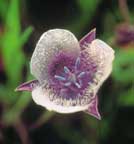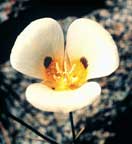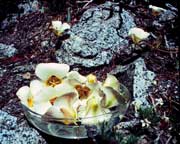Calochortus - Lily Family Plants
Lily Family plants have simple, linear leaves and three-petaled flowers, usually with three sepals below. The six-pointed star is a symbol of the Lily form, representing two interpenetrating triangles, Heavenly and Earthly, alchemical symbols of fire and water. Lily plants grow from a watery bulb and are lightly rooted. They can survive when removed from the earth for significant periods of time. Thus Lily flowers represent a connection to the cosmic, archetypal world; and generally embody the feminine, receptive mode. We have found flower essences from the Lily family to be helpful with women's issues, sexuality, developing soul sensitivity and nurturing. The four flowers pictured here are all members of the Calochortus genus, and thus share an even closer botanical kinship within the Lily Family. Calochortus (Greek for "beautiful grass) flowers – the Mariposa Lilies, Sego Lilies, and Star Tulips – have the most refined, subtle petals, often covered with delicate hairs. Their essences work with some of the intimate issues of the soul, developing many aspects of receptivity and sensitivity. |
This delicate white lily grows in high, alpine, rocky terrain, and has been called the "Madonna of the Rocks." Its tiny bulb barely anchors the plant in the ground, while its large, expansive flower spreads its petals above. Mariposa (Spanish for "butterfly") Lily is a characteristic example of the cosmic, feminine qualities of Lily Family. Mariposa Lily brings the Heavenly nurturing forces of the Archetypal Mother to protect the natural innocence of childhood from the harshness of life. The flower essence is especially indicated for child abuse and abandonment, for children with disabilities, for disturbed birthing or premature births, or for other traumas in the early bonding between child and mother. It is also outstanding for many adult therapeutic issues which involve reclaiming original childhood pain or trauma. Thus Mariposa Lily brings the sensitive, receptive qualities of the Calochortus to deal with the traumatic experiences of life that can often close and harden the soul. |
| Star Tulip grows along the Star Tulip: Its botanical name of Calochortus Star Tulip is also known as coast of the Pacific Ocean means "beautiful grass" in Greek "Pussy's Ears" |
 |  |  |
Star Tulip Calochortus tolmiei Also called "Pussy's Ears," this Star Tulip is native to the western coast of the United States. It is a marvelous picture of feminine sensitivity, with its delicate mauve color, and flower petals filled with exquisite hairs. The flower essence develops inward receptivity, the capacity to listen and receive from others, with a more inward, or meditative soul life, greater awareness of dreams and inner guidance. Of various Calochortus flower essences this Star Tulip – which grows on the mist and fog-enshrouded coastal bluffs – is the most inward in its effects, enhancing meditation, dream recall, and particularly encouraging men to contact their anima, or inner feminine qualities. Yellow Star Tulip Calochortus monophyllus Found in the foothills of the Sierra Nevada mountains, the Yellow Star Tulip is a bit taller and more robust that its coastal sister, with a bright yellow color. Yet, like the Star Tulip, it has a soft, receptive interior of fine hairs. Yellow Star Tulip essence also works with issues of sensitivity, but more outwardly. It helps us to feel what others are feeling, and to sensitize ourselves to our environment, thus developing qualities of empathy and understanding. Fairy Lantern Calochortus albus Like its sister Calochortus flowers, the Fairy Lantern has soft, delicate downy petals. However, it hides its "secret," never fully opening, but hanging downward in a globe-like shape, instead of unfolding upward towards the sun. This gesture of remaining closed, of delicate fragility which pulls away from earthly contact, corresponds to the clinical use of the flower remedy. Those who need Fairy Lantern often remain in a childlike or overly dependent stage of development, emotionally and/or physically. This essence has been helpful in some cases of anorexia nervosa. Thus the Fairy Lantern works somewhat differently with the theme of sensitivity than the other Calochortus essences, helping those who have become too "yin," who need to balance their desire for receptivity with a willingness to come into their full strength as adults. |

To install this Web App in your iPhone/iPad press ![]() and then Add to Home Screen.
and then Add to Home Screen.




